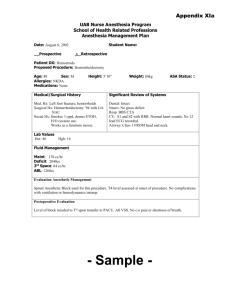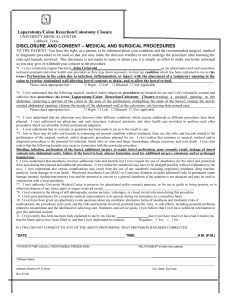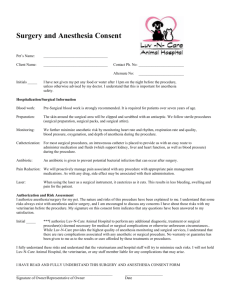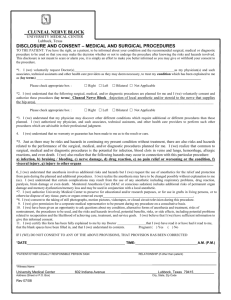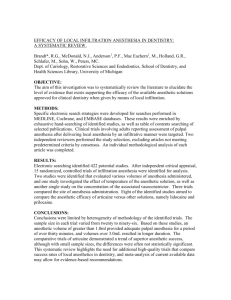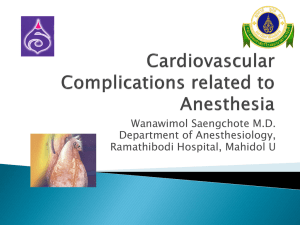Mystery Diagnosis: A Labyrinth Through Trombophilia
advertisement
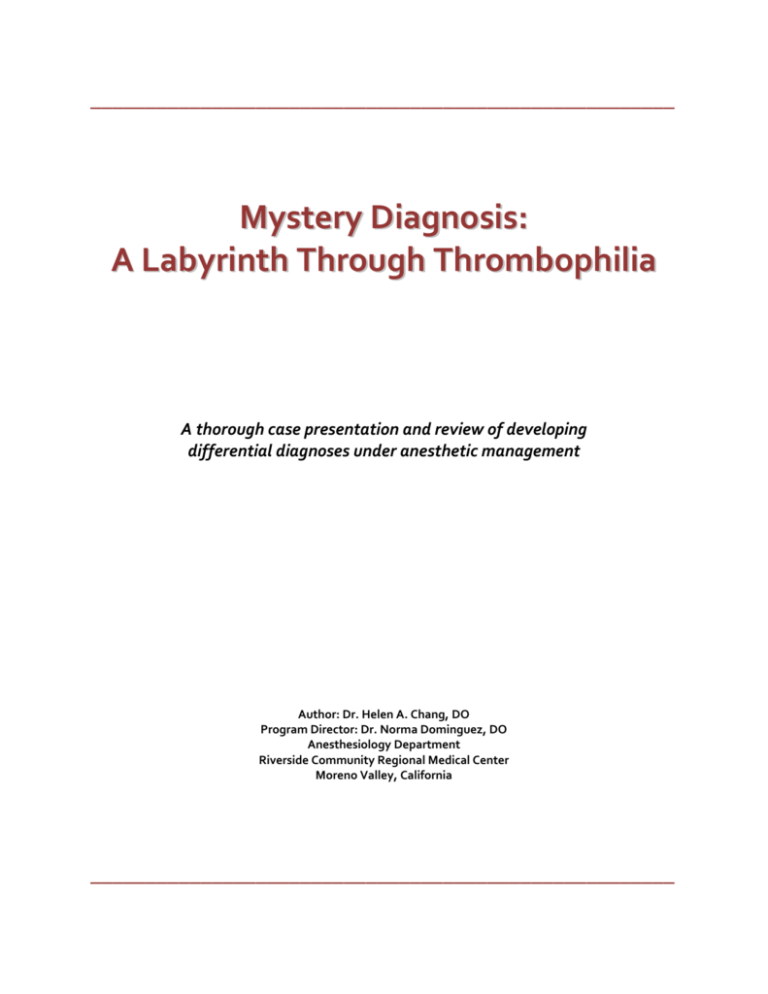
_____________________________________________________ Mystery Diagnosis: A Labyrinth Through Thrombophilia A thorough case presentation and review of developing differential diagnoses under anesthetic management Author: Dr. Helen A. Chang, DO Program Director: Dr. Norma Dominguez, DO Anesthesiology Department Riverside Community Regional Medical Center Moreno Valley, California _____________________________________________________ “Intuition will tell the thinking mind where to look next.” Jonas Salk _____________________________________________________ I. Title: Perioperative Detectives: An Undiagnosed Thrombophilia II. Abstract: Thrombophilia encompasses many disorders that are not frequently diagnosed in circumstances when a patient requires urgent surgical intervention. Inherited thrombophilias are a heterogeneous group of rare genetic disorders and strongly associated with an elevated risk of venous thromboembolism. In particular, Protein C and S deficiencies may be characterized on a systemic approach; however, many individuals do not exhibit clear symptoms. We present a rare case of a patient requiring an exploratory laparotomy for perforated necrotic bowel without a definitive diagnosis. Based on our preoperative evaluation, we attributed the patient’s rapid clinical decline to a life-threatening thromboembolic disorder with systemic manifestations. III. Introduction: When a clinically unstable, young patient requires anesthesia for an urgent exploratory laparotomy for a bowel obstruction, suspicion should arise as to the etiology for a rapid clinical decline. Rather than attributing the root cause to more common causes, it is important for anesthesiologists to approach a patient systematically when no clear diagnosis has been made by the primary medical service. Severe homozygous protein C deficiency occurs in approximately 1 in 500,000 to 1 in 750,000 individuals. The risk of venous thromboembolism in this population is roughly seven-fold over that of the general population. The most common site for risk of thrombosis is the mesenteric vein. Congenital protein S deficiency is an autosomal dominant disease and rare in the healthy population. Symptoms related to protein S deficiency are those associated with deep venous thrombosis, thrombophlebitis, or pulmonary embolus.3 `In the following discussion, we present the case history and anesthetic management with a working diagnosis of thrombophilia. 3 IV. History: A 37 year-old African-American female with past medical history of diabetes mellitus type 2 and recent vaginal yeast infection presented to the emergency department with a chief compliant of abdominal pain. It was described as acute onset, one week duration, and non-localized pain. Associated symptoms included nausea, vomiting, and chills. Due to persistent nausea and decreased dietary intake, patient did not take oral diabetic medications and denied use of other medications to provide symptomatic relief. In review of systems, patient denied dizziness, loss of consciousness, or seizure activity. Patient denied chest pain, palpitations, dyspnea, hemoptysis, and wheezing. Patient stated that she was not producing adequate urine and used tampons regularly for menstrual cycles, of which commenced one week prior to the onset of symptoms. Other systems were otherwise unremarkable. Aside from diabetes and a yeast infection, patient denied other medical problems. Per surgical history, she reported an uncomplicated cesarean section under spinal anesthesia and a laparoscopic cholecystectomy. Social history was remarkable for a 20-year tobacco history. Due to recent unemployment status, she had been rather sedentary in her household. Aside from diabetes, myocardial infarction, and coronary artery disease, patient denied any clotting disorders in immediate family members. In the emergency department, the initial vital signs included: oral temperature 36.5, pulse 130, respiratory rate 22, blood pressure 142/78, oxygen saturation on room air 99%. A high suspicion for diabetic ketoacidosis (DKA) or hyperglycemic hyperosmolar nonketotic coma (HHNK) led to a hospital admission and further workup. Urine analysis and chest radiograph ruled out possible sources of infection. Baseline electrocardiogram showed sinus tachycardia at 148 bpm without evidence of myocardial wall ischemia or infarct. Initial venous blood gas revealed: 7.27/27/39.8/11.9/-13.6 on 21% fraction of inspired oxygen and hemoglobin 8.7. With initial chemistry panel glucose of 408, white blood cell count of 13.3, tachycardia, and anion gap of 27, patient was admitted to the intensive care unit with a diagnosis of diabetic ketoacidosis (DKA) due to medication non-compliance and treated accordingly with aggressive fluid resuscitation and an insulin drip. The in-patient hospital course goes as follows: on hospital day (HD) #1, the patient remained tachycardic with persistent leukocytosis despite appropriate treatment for DKA and her abdominal pain did not improve. A computed tomography scan of the abdomen and pelvis revealed findings suggestive of partial small bowel obstruction with gastric distension, but no evidence of an abscess or infectious process. A complementary abdominal ultrasound revealed right cortical renal cyst, increased echogenecity of the liver and fatty infiltration versus diffuse hepatocellular disease. The patient’s clinical picture continued to deteriorate and broad spectrum antibiotics were added to the treatment regimen. Unfortunately, she decompensated rapidly and met criteria for septic shock at which time vasopressors were initiated. On HD #2, a concern for bilateral lower extremity vascular insufficiency attributed to an acute onset of skin discoloration and decreased palpable pulses. A lower extremity arterial doppler study revealed no flow detection in the right posterior tibial and dorsalis pedis artery, severe peripheral vascular disease of the superficial femoral and popliteal arteries, and significant stenosis distal to the superficial femoral artery. A heparin drip was initiated with simultaneous consultation of vascular surgery to evaluate for surgical options, however, conservative management was recommended at that time. On HD #3, concerns for a hypercoaguable state and in the setting of septic shock led the primary internal medicine team to evaluate cardiac function in their workup. A transthoracic echocardiogram revealed hyperdynamic left ventricular systolic function with an ejection fraction >70%. At this time, a series of tests were ordered for a complete hypercoagulability panel per a hematologic consultation. A second CT scan on HD #5 showed new low attenuation areas within the liver and spleen consistent with possible ischemia or infarct. Additionally, mild free fluid was found throughout the abdomen and edematous mesentery was increasingly concerning. Despite worsening clinically, the patient was deemed competent to make her own decisions. Documentation showed the patient refused the recommendation of surgical treatment on multiple occasions. Due to the patient’s desires, a non-surgical approach with bowel regimens and a nasogastric tube was implemented by the general surgery team. Meanwhile, the patient continued to decompensate with acute kidney injury on HD #11 and nephrology initiated emergent hemodialysis through a right internal jugular quinton non-tunneled catheter. The patient did not tolerate removal of than 800 cc at which time hemodialysis terminated. Furthermore, to rule out endocarditis as a source of infection and showering emboli, a transesophageal echocardiogram did not identify valvular vegetation. However, this study revealed mild concentric left ventricular hypertrophy, persistent hyperdynamic left ventricular function, and a complex (>4cm) atherosclerotic plaque in the descending aorta beyond the origin of the left subclavian artery with a large 1.5cm overlying protruding mobile thrombus. Serum levels of substances associated with liver injury steadily increased by this time. Aspartate and alanine transaminase levels were moderately elevated. Prothrombin and activated partial thromboplastin times were prolonged, 17.8 and 78.3 respectively. International normalized ratio climbed to 1.6 and serum albumin dropped to 1.3. Platelet values, however, remained in normal range. With a multi-disciplinary approach, the etiology for the patient’s pathologic disorder was not clearly determined. Results from multiple hematologic studies were still pending and the concerns for abdominal compartment syndrome led to a discussion with the patient and her family for surgery. Ultimately, they provided informed consent for an exploratory laparotomy and possible bowel resection. V. Anesthetic Plan and Management: We received this 37-year old, 85 kilogram and 5’5” patient in the preoperative holding area on HD #14 on facemask of 15 liters of oxygen, off vasopressors, a peripheral inserted central catheter (PICC), and in a clinical state of septic shock. There still remained a lack of etiology for these clinical manifestations. She appeared edematous, diaphoretic, and lethargic. No jugular venous distension, murmurs or gallops were noted on cardiovascular exam. The abdomen was distended and lung sounds were clear yet diminished due to poor inspiratory effort. The pressure of bilious content within the nasogastric tube (NGT) superseded the clamp, and upon flushing each PICC port, only two were functional. Our anesthetic management included: suctioning the NGT prior to induction, secondary suction, having a glidescope readily available and ramping for airway optimization, rapid sequence induction with cricoid pressure, serial blood glucose monitoring, arterial line with two large bore intravenous lines, Hotline, blood products, muscle paralysis, and vasopressors readily available. We induced with propofol 70mg and succinylcholine 80mg via a rapid sequence induction. Under direct laryngoscopy with the glidescope, we obtained a grade III view and intubated successfully. The view screen noted thickened plaques covering the epiglottis and arytenoids, and suction was not effective in removing the plaques. A large bore IV was inserted and connected to a Hotline. Initial difficulty with arterial line placement was assisted with ultrasound guidance, and evidence of atherosclerosis or intra-arterial thrombi were noted. This explained our multiple attempts to initially thread the guidewire. For anesthetic maintenance, we administered hydromorphone, cisatracurium for sustained paralysis of Train of Four (TOF) no greater than ¼, and 0.5 MAC of sevoflurane. The patient’s blood pressures remained in ranges of 100-110 systolic and 50-60 diastolic. Mean arterial pressures remained greater than 60. Heparin intravenous infusion was discontinued at time of skin preparation per surgeon request. Total parenteral nutrition was continued at 25 cc/hr and two units of fresh frozen plasma were received intraoperatively once surgical time commenced. Our initial intraoperative arterial blood gas revealed: 7.36/39/87/22/-3 on 97% FiO2 with hemoglobin 8.9. Once the surgeon reached the bowel, multiple long segments of necrotic bowel and transmural bowel perforations extending from the Ligament of Treitz to the hepatic flexure of the right colon were found. Due to the surprisingly extensive nature of surgical findings, the family was informed of the poor prognosis intraoperatively. After a family conference, a consensus was made to not dissect the necrotic bowel and close the abdomen with a wound vacuum assisted closure (VAC) device. During the case, notable changes in end-tidal CO2 were not detected; however, the patient required increased pressure support to maintain adequate minute ventilation. Estimated blood loss was approximately 50 cc and total nasogastric tube output was 900 cc. Over the total anesthesia time of 3 hours and 5 minutes, the patient made less than 10 cc of urine. No vasopressor was administered throughout the case. After successful resuscitation and intraoperative anesthetic management, the patient remained intubated and transported directly to the intensive care unit without subsequent remarkable events. VI. Discussion When we received report of an urgent add-on general surgical case, only brief medical history was provided. It was limited to the lack of a primary diagnosis although multiple diagnostic studies pointed to systemic manifestations of coagulopathy. The patient was transported to our pre-operative holding area and based on a brief glimpse of the patient and monitor, she was unstable. Thankfully, the patient was alert and responsive to our questions to investigate more about her relevant history. A majority of our assessment to generate an anesthetic plan was based on the patient interview and bedside examination. Interesting points from the 3 minute discussion with the patient included: recent tampon use, absence of lower extremity skin discoloration prior to hospital admission, history of constipation for two weeks, dyspnea on exertion, and worsening malaise despite compliance with home diabetic therapeutic regimen. The curiosity and complexity of the clinical picture led us to start devising a differential diagnosis, which included toxic shock syndrome, heparin-induced thrombocytopenia, thrombophilia, and endocarditis.3 Several of the diagnostic studies revealed the contrary; however, we could not rule out certain diagnoses based on the timeline of her clinical deterioration. The plan to approach the patient’s condition from a systematic approach helped us organize possible contraindications to a specific action in anesthetic management. Anticipation of surgical findings and complications prepared us to react, if necessary. The following dialogue represents our thought process for the case: The patient’s neurologic status was rather intact at time of presentation; however, we did not implement agents such as ketamine or midazolam with potential side effects of delirium and worsening hallucinations. If an anticholinergic agent was necessary, glycopyrrolate may have been the agent of choice over atropine due to central nervous system side effects. Although the most recent transesophageal echocardiogram revealed no valvular vegetations, we could not exclude the possibility of a new development of vegetation in the setting of septic shock and a hyperdynamic ventricle. Quote: “similar lesions probably occur naturally in bacteremic humans with congenital or acquired cardiac lesions that induce continuous endocardial trauma via regurgitant flow or high pressure jets.”9 Based on a hyperdynamic left ventricular systolic function, we decided the patient was in a state of high cardiac output to account for a low systemic vascular resistance and concomitant increased end-organ metabolic demands. A low threshold for cardiovascular collapse was imminent. The patient was never on positive-pressure or mechanical ventilator support prior to surgery. With septic shock or DKA, respiratory function is represented by lower functional reserve capacity (FRC), lower tidal volumes, and ultimately lower minute ventilation. 3 We anticipated elevated arterial carbon dioxide tension (PaCO2) and a decreased ventilation: perfusion ratio. When reviewing the trend of chest radiographs, markers of pulmonary edema were evident. Understanding a strong association of septic shock with Acute Respiratory Distress Syndrome (ARDS), we anticipated difficulties with ventilation and oxygenation once under general anesthesia. Our plan was to maintain muscle paralysis, implement positive end-expiratory pressure (PEEP), and maintain higher respiratory rates. Abdominal Compartment Syndrome (ACS) was another concern for perioperative anesthetic management. Various systems are involved in this syndrome. First, the increased intra-abdominal pressure is transmitted to the pleural space in that lung compliance decreases.1 Alteration of ventilation: perfusion leads to hypoxemia and hypercapnia. High inspiratory pressures are often required to deliver adequate tidal volume. Second, the combination of increased abdominal pressure and pleural pressure leads to decreased venous return, direct compression of the myocardium, and increased afterload. Third, combined effects of decreased cardiac output, increased interstitial pressure, and increased outflow pressure can lead to reduced perfusion of intra-abdominal organs. 1 For example, renal failure may ensue. To make matters worse, extensive bowel obstruction causes fluid shifts into extracellular space and further worsen abdominal compartment syndrome. If the discoloration of lower extremities was due to a low-flow state, then it was important to maintain hemodynamic stability. Weighing the risk and benefits of vasopressor at this time warranted the preparation of phenylephrine, norepinephrine, and epinephrine in the forms of continuous intravenous infusion and syringes. Since the patient was on multiple anti-microbial and anti-fungal intravenous medications, it was important to have re-dosing of these drugs in a timely manner. With the main focus on thrombophilia, communication with the surgical team regarding the termination of therapeutic heparin and infusion of fresh frozen plasma was critical.10 We could not predict the possibly clinical manifestations of stopping heparin. In preparation for real-time surgical evidence of persistent clotting throughout the mesentery, we kept the heparin drip on hold and had heparin boluses readily available. A keen eye towards pulmonary embolism and possibly circulatory collapse was also important. A constellation of intraoperative signs included an abrupt decrease in end-tidal carbon dioxide, hypotension, or tachycardia. We prepared with heparin, thrombolytics, and Advanced Cardiac Life Support protocol. Figure 1: Lower Extremity Vascular Insufficiency Note black arrow indicating length of skin discoloration on right lower extremity associated with gangrene A correlation between end-organ findings of hypoperfusion and highly suspected microemboli throughout the small bowel put this patient at risk for pulmonary embolism in the perioperative setting. 11 Indeed, she was initiated on therapeutic doses of heparin, however, clinical manifestations of coagulopathy persisted. Patient had bleeding at venipuncture sites uncontrolled by application of a pressure dressing. Although the core temperatures may have been approaching a febrile state, the extremities were cold to touch. Devising a differential diagnosis in a time-pressured manner is oftentimes at the helm of the anesthesiologist. Although our patient did not have a working diagnosis, we were highly suspicious of the following: infectious source with associated septic shock; hypercoagulopathy leading to thrombotic events; vascular insufficiency secondary to low cardiac output state; or hereditary coagulation disorders. These manifestations would directly affect our anesthetic management with hemodynamic stability, mechanical ventilator management, and optimization of acid-base balance. Since there are many varieties and clinical endpoints associated with hereditary coagulation disorders, our main focus was to resuscitate the patient and monitor closely for intraoperative thrombotic events. VII. Conclusion It is imperative to become vigilant anesthesiologists and assume the role as a clinical investigator when a patient arrives for an urgent surgery without a definitive diagnosis. Utilizing diagnostic tools, efficiently reviewing a patient’s medical workup, and discussing the case thoroughly with the surgical team are all important. With more experience, intuition becomes an invaluable tool. In a residency teaching environment, there are human resources that provide additional thought-provoking input when an unusual case is presented. The experience of providing anesthesia for unique cases such as this challenges our role as a clinical diagnostician and enhances the practice of intuition that will remain with us forever. VIII. Epilogue In the anesthetic post-operative follow-up period, I personally continued the discussion with the primary medicine team. Curiosity still loomed on the primary etiology that culminated in such a devastating clinical outcome. The main finding of Protein C and S deficiencies became the identifying cause of thrombophilia. The deficiency of AT III activity was attributed to the patient developing DIC.4, 10 I acquired some pertinent data and special laboratory findings which I listed below in Table 1. Table 2 offers interpretations and explanations for various items tested. Table 2: Laboratory Findings5 Test Name Value In Range? Y / N Homocysteine, Cardiovascular 7.8 Y (<10.4) Haptoglobin 28 (L) N (43-212) Cardiolipin AB Screen w/ Reflex to IgG, Negative -- IgA, IgM Beta-2-Microglobulin 8.85 (H) N (<2.51) Antithrombin III Activity 43 (L) N (80-120) Prothrombin Gene Analysis (G20210A Not Detected -- Lupus Anticoagulant Not Detected -- ANA IFA Screen Negative -- ANCA Screen w/ MPO and PR3 Reflex <6 Y (<6) 15 (L) N (70-180) Mutation) to ANCA Titer Protein C Activity Protein S Activity 17 (L) N (60-140) HCV RNA, Quantitative RT-PCR Not Detected -- Heparin Induced Thrombocytopenia Negative -- Negative -- Panel Serotonin Release Assay Heparin Induced Platelet Antibody Table 2: Interpretations ATIII Antithrombin III (AT III) was noted to be decreased from normal range; however, major differential diagnosis of hereditary AT III deficiency includes consumption (i.e. recent thrombosis or DIC), heparin therapy, and nephritic range proteinuria. Of note, an elevated AT III is not clinical significant. LA Lupus Anticoagulants (LA) may be associated with thrombotic events, recurrent abortion, or may be asymptomatic. A bleeding history requires other coagulopathies be excluded. Since LA may be transient, international consensus guidelines suggest waiting at least 12 weeks before retesting to confirm antibody persistence. (J Thromb Haemost 2006:4;295). SRA Although the result of this patient’s sample is negative, a small percentage of patients may still be positive by the Serotonin Release Assay (SRA), possibly due to other target antigens involved in this reaction such as Interleukin-8 or Neutrophil-Activating Peptide-2 (NAP-2). (Curr Hematol Rep. 2003:2;148-157). ANCA Prothrombin Gene ANCA screen includes evaluation of p-ANCA, c-ANCA, and atypical p-ANCA. The G20210A mutation in the Prothrombin/Factor II gene is the second most common inherited risk factor for thrombosis occurring in approximately 2% of Caucasians. Presence of the mutation is associated with an elevation of prothrombin levels to about 30% above normal in heterozygotes and to 70% above normal in homozygotes. APS The Antiphospholipid Antibody Syndrome (APS) is a clinical pathologic correlation that includes a clinical event (e.g. thrombosis, pregnancy loss, thrombocytopenia) and persistent positive Antiphospholipid Antibodies (IgM or IgG ACA >40 MPL/GPL, IgM or IgG anti-B2GP1 antibodies, or a Lupus Anticoagulant). (J Thromb Haemost 2006:4;295). Protein S The marked reduction in functional Protein S is often associated with a prothrombotic state and is compatible with hereditary deficiency. Family studies may be helpful. Acquired causes of Protein S deficiency include: Lupus anticoagulant, L-asparaginase therapy, second and third trimester pregnancy, nephrotic syndrome, acute thrombotic event, and D.I.C. Decreased levels of Protein S activity may be found in patients with hereditary deficiency, warfarin therapy, vitamin K deficiency, liver disease, DIC, or recent thrombosis as well as after surgery. In addition, it may be physiologic in pregnancy. An elevated Protein S activity is not clinically significant. Protein C Decreased levels of Protein C activity may be found in hereditary deficiency, treatment with oral anticoagulants, liver disease, D.I.C. and post surgery. Only deficiencies are associated with an increased thrombotic risk. VIX. Referenced Literature 1. “Abdominal Compartment Syndrome.” Daniel De Backer. Department of Intensive Care, Erasme University Hospital, Free University of Brussels. Critical Care. 1999; 3(6):R103-R104. 2. Barash, Paul G et al. Clinical Anesthesia. Lippincott Williams & Wilkins; 6th edition, Apr 14, 2009. 3. Braunwald, Eugene et al. Harrison’s Manual of Medicine. McGraw-Hill; 15th edition, 20o2. 4. Canadian Journal of Surgery. “Protein C Deficiency and Mesenteric Venous Thrombosis.” Dina Rharrit, MD et al. Canadian Medical Association, 2009 Apr; 52(2): E35-E37. 5. Clinical Laboratory Science Review. Harr, Robert. F.A. Davis Company; 3rd edition, Nov 27, 2006. 6. Miller, Ronald D. Miller’s Anesthesia. Churchill Livingstone; 6th edition, Sep 22, 2004. 7. Morgan, Mikhail, and Murray. Clinical Anesthesiology. McGraw-Hill Medical; 4th edition, Aug 26, 2005. 8. “Perioperative Medical Management of Antiphospholipid Syndrome: Hospital for Special Surgery Experience, Review of Literature, and Recommendations.” The Journal of Rheumatology. Doruk Erkan et al. Volume 29, no. 4; 843-849. 9. “Pathogenesis of Vegetation Formation in Infective Endocarditis.” Sexton, Calderwood, and Baron. UpToDate 19.3, Jul 23, 2010. 10. Sniecinski, Roman M et al. “Etiology and Assessment of Hypercoagulability with Lessons from Heparin-Induced Thrombocytopenia.” Anesthesia & Analgesia. Dec 1, 2011; 113:1319-1333. 11. “Systemic Thromboembolism in Inflammatory Bowel Disease: Mechanisms and Clinical Applications.” Annals of the New York Academy of Sciences. 9 Jan 2006, volume 1051, pages 166-173.
